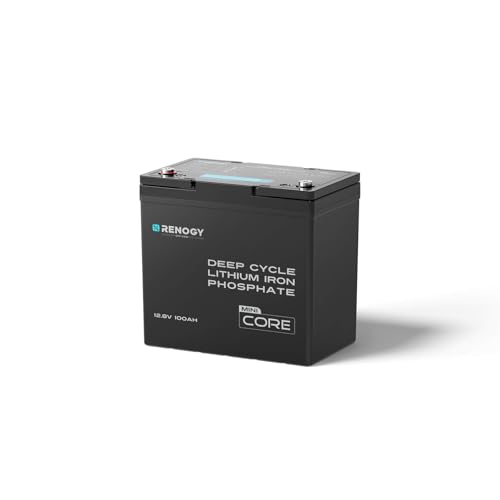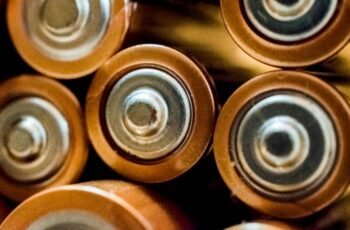If we’re planning serious off-grid power in 2025, Renogy’s latest LiFePO4 lineup gives us dependable options for RVs, cabins, boats, and overlanding. From cold-ready, self-heating packs to compact Group 31 builds and high-discharge trolling motor batteries, each pick solves a specific use case. We’ll quickly compare capacity, BMS limits, protection ratings, and scalability—plus a smart charger bundle that ties it all together—so we can choose confidently. Here’s where the trade-offs get interesting.
Key Takeaways
- Renogy 12V 200Ah Bluetooth Self-Heating LiFePO4 (Pro Series): 5000+ cycles, IP67, self-heating, Bluetooth, robust BMS; ideal for cold, demanding off-grid setups.
- Renogy 12V 100Ah LiFePO4 Two-Pack with 100A BMS: scalable, compact Group 31 footprint, IP65, great value for building 12V banks up to 20.48 kWh.
- Renogy 12V 100Ah LiFePO4 Trolling Motor Battery: IP67, 150A continuous/300A surge, Bluetooth; lightweight Group 24 for high-draw, space-limited marine or RV loads.
- Renogy 12V 100Ah LiFePO4 Core Mini: ultra-compact, 100A BMS, IP65, any-orientation mounting; maximizes storage in tight camper, van, or portable systems.
- 12V 40A DC-DC Charger + BT-2 Bundle: protects alternators, optimizes LiFePO4 charging, app monitoring; essential companion for reliable vehicle-based off-grid charging.
Renogy 12V 200Ah Bluetooth Self-Heating LiFePO4 Deep Cycle Battery (Pro Series)
November 19, 2025 10:19 pm
If you need a rugged, cold‑weather-ready house battery for RVs, boats, or off‑grid cabins, Renogy’s 12V 200Ah Pro Series LiFePO4 stands out with self‑heating, Bluetooth monitoring, and an IP67, corrosion‑resistant build. We like its 5000+ cycles, V-0 fire‑retardant casing, and wobble‑free design with mounting brackets. The double active safety design and 60+ BMS protections add confidence, while auto‑heating safely resumes charging in the cold. It weighs 50.6 pounds and measures 8.4 x 18.4 x 8.2 inches. Use a purpose‑built charger; avoid direct alternator charging. Note mixed reports on port corrosion and water ingress. Firmware, shelf mode, and parallel setups need care.
Best For: RVers, boaters, and off‑grid cabin owners who need a rugged, cold‑weather‑capable 12V house battery with long cycle life, Bluetooth monitoring, and enhanced safety features.
Pros:
- Self‑heating with overheat protection enables safe charging and operation in cold climates
- 5000+ cycles, V‑0 fire‑retardant casing, IP67 dust/water resistance, and corrosion‑resistant build
- Double active safety design with 60+ BMS protections, plus robust mounting brackets and Bluetooth monitoring
Cons:
- Reports of port corrosion and potential water ingress despite IP rating; real‑world sealing may vary
- Requires a purpose‑built charger; direct alternator charging can cause overcurrent/overheating
- Firmware/shelf‑mode nuances and parallel bank setup may need cables, updates, and careful configuration
12V 100Ah LiFePO4 Lithium Battery (2 Pack) with Built-in BMS for RV, Solar, and Off-Grid
November 19, 2025 10:19 pm
Serious RVers, off‑grid homeowners, and boaters who want lightweight power with long service life will zero in on this 12V 100Ah LiFePO4 two-pack, each Group 31 unit packing A+ grade cells and a built-in 100A BMS. We get 25.3 lb batteries (13.0 x 6.77 x 8.43 inches) that are about half the size and 65% lighter than lead-acid, yet deliver 4000+ cycles and a 10-year lifespan. Stack up to 4s4p for banks to 20.48 kWh. Safety’s robust: UL/FCC/CE/RoHS/UN38.3, IP65, low-temp charge protection, and full BMS safeguards. Charge with a LiFePO4-specific charger at ~0.2C. Backed by responsive support and a 30-day return.
Best For: RVers, off‑grid homeowners, boaters, and solar users who need lightweight, long‑life 12V power with robust safety and scalable capacity.
Pros:
- Long lifespan and durability: 4000+ deep cycles, up to 10 years; A+ grade LiFePO4 cells with 100A BMS
- Lightweight and compact: 25.3 lb Group 31 size—about half the size and 65% lighter than equivalent lead‑acid
- Scalable and safe: supports up to 4s4p (20.48 kWh), IP65, low‑temp charge protection, and UL/FCC/CE/RoHS/UN38.3 certifications
Cons:
- Requires LiFePO4‑specific charger and optimal charging at ~0.2C for best health
- Low‑temperature charging auto‑disconnect below 32°F may limit winter charging without heating
- Higher upfront cost versus standard lead‑acid (though lower total cost over lifespan)
Renogy 12V 100Ah LiFePO4 Trolling Motor Battery (Bluetooth, 100A BMS, IP67)
November 19, 2025 10:19 pm
Built for anglers who demand waterproof grit and high current, the Renogy 12V 100Ah LiFePO4 Trolling Motor Battery pairs IP67 sealing with a 150A continuous discharge (300A surge) to drive 12V–36V setups confidently. We get Group 24 dimensions at just 21.8 lbs—about half the weight of lead-acid and two-thirds the volume of Group 31—so you reclaim space for gear. The 150A BMS with 25+ protections and low‑temp cut-off keeps performance safe in rough water and cold snaps, even if the compartment floods. Bluetooth 5.3 links to the Renogy App for real-time stats. Beyond boats, it powers RVs, workshops, and off-road builds.
Best For: Anglers and outdoor enthusiasts who need a lightweight, waterproof, high-current 12V power solution for trolling motors (12V–36V) and versatile off-grid use.
Pros:
- High output: 150A continuous (300A surge) drives demanding trolling motors and accessories
- Rugged and reliable: IP67 waterproof, low-temp cut-off, and 150A BMS with 25+ protections
- Compact and light: 21.8 lbs Group 24 size—about half the weight of lead-acid and 2/3 the volume of Group 31
Cons:
- Higher upfront cost than comparable lead-acid batteries
- Requires compatible LiFePO4 charger and setup for optimal longevity
- Group 24 capacity may be limiting for all-day multi-motor or heavy accessory loads without parallel packs
Renogy 12V 100Ah LiFePO4 Lithium Battery (Core Series)
November 19, 2025 10:19 pm
Compact power defines Renogy’s 12V 100Ah LiFePO4 Core Mini, making it a standout for tight installs in teardrop trailers, kayaks, and space-constrained RV bays. At 9.02 x 5.43 x 8.39 inches and 22.7 pounds, it’s 50% smaller than Group 31 and 13% smaller than typical 100Ah minis, yet delivers true deep-cycle performance for 12V fridges, fans, and solar banks. We get a 100A BMS with low/high temp, over/under-voltage, overcurrent, and short-circuit protections, plus UL-listed EV-grade prismatic cells. IP65 keeps dust and splashes out. Mount in any orientation (not upside down). Add Renogy’s 300A shunt for app monitoring. Warranty and returns via product page.
Best For: Space-constrained RVers, teardrop trailer owners, kayakers, and off-grid users who need a compact, lightweight 12V 100Ah LiFePO4 battery with robust protections and optional app monitoring.
Pros:
- Ultra-compact and light (9.02 x 5.43 x 8.39 in; 22.7 lb), 50% smaller than Group 31 for tight installs
- 100A BMS with temp, voltage, current, and short-circuit protections; UL-listed EV-grade prismatic cells; IP65 rating
- Flexible mounting in any orientation (except upside down) and optional shunt-based app monitoring via DC Home/Renogy ONE
Cons:
- No built-in Bluetooth; requires separate 300A shunt for monitoring
- Single 100A BMS may limit high-surge loads compared to higher-amp alternatives
- Warranty specifics not fully detailed here; mixed service experiences noted by some users
12V 40A DC-DC Battery Charger with BT-2 Smart Solar Monitor Bundle
November 19, 2025 10:19 pm
If you need a rugged, app-connected way to charge house batteries from your alternator, the RENOGY REGO 12V 40A DC-DC Battery Charger with BT-2 Smart Solar Monitor is a standout. We like its 40A output, LiFePO4 activation, and universal compatibility with lithium, AGM, gel, and flooded batteries. The IP54 design handles -4°F to 185°F, with overload, short-circuit, and over-voltage protection plus smart thermal management.
With the BT-2 and Renogy DC Home app (82 ft range), we track live battery and inverter stats, set voltage alerts, and review 365-day logs and 30-day reports. Installation’s simple: wall-mount, plug-and-play RJ45, RS485 daisy-chaining, and intelligent alternator detection.
Best For: RV, van, truck, and marine owners who want a rugged, app-connected 12V DC‑DC charger to safely charge and monitor lithium or lead‑acid house batteries from an alternator.
Pros:
- 40A DC‑DC charging with LiFePO4 activation and universal battery compatibility (Lithium, AGM, Gel, Flooded)
- IP54 durability with wide temperature range (-4°F to 185°F) and robust protections (overload, short-circuit, over-voltage, thermal)
- BT‑2 + Renogy DC Home app enables 82 ft wireless monitoring, voltage alerts, 365‑day logs, and 30‑day reports
Cons:
- Requires mounting and wiring space; not as plug‑and‑play as a simple trickle charger
- IP54 is weather-resistant but not fully waterproof/submersible (may need protected placement)
- App functionality depends on BT‑2 range and phone connectivity; advanced features add setup complexity
Factors to Consider When Choosing Renogy LiFePO4 Batteries
Let’s weigh the essentials: capacity and voltage for system fit, cycle life rating for long-term value, and BMS protections for safety and performance. We’ll also look at size and weight to match our space and portability needs. Finally, we’ll check environmental resistance so the battery handles heat, cold, moisture, and vibration.
Capacity and Voltage
Why do capacity and voltage matter when we pick a Renogy LiFePO4 battery? Because they determine how much energy we can store and how well the system integrates with our gear. Renogy’s 12V packs fit standard RV, marine, and off-grid setups, so voltage alignment is straightforward.
Capacity, rated in amp-hours (Ah), tells us how long the battery can deliver current at a given draw. A 200Ah pack stores roughly twice the energy of a 100Ah pack (in watt-hours, Ah × 12V), but it’s larger and heavier. We should size capacity to our daily loads, recharge window, and space constraints.
Cycle Life Rating
How long will a battery really last? When we compare Renogy LiFePO4 options, the cycle life rating gives us a clear benchmark. It tells us how many full charge‑discharge cycles the battery can deliver before capacity falls to a set threshold—typically about 80% of its original capacity.
Renogy’s 2025 LiFePO4 models commonly advertise 4,000 to 5,000+ deep cycles, far beyond lead‑acid. That durability stems from LiFePO4’s stable chemistry, which resists capacity fade better than traditional lead‑acid and even many other lithium chemistries.
We should also check the test conditions. Stated cycle life usually assumes moderate 0.2C–0.5C charge/discharge rates. In the real world, temperature, higher C‑rates, and overall system settings can reduce or enhance outcomes. Match your usage profile to the rating to estimate true lifespan.
BMS Protections
What keeps a lithium battery safe and steady day after day? Robust BMS protections. When we evaluate Renogy LiFePO4 batteries, we look for comprehensive safeguards: overcharge, over-discharge, overcurrent, overheating, and short-circuit protection. Renogy’s systems boast 60+ safety features and built-in 100A or 150A BMS units that continuously monitor cells, balance them, and prevent thermal runaway.
Cold weather matters, too. Low-temperature charging protection automatically halts charging at subfreezing temps and resumes above the set threshold, preserving cell integrity. For hardware faults, self-control fuses—Active Backup Protection—break the circuit during overheating or component failure to avert cascading damage.
Finally, IP-rated, UL-listed enclosures complement the BMS by resisting dust, water, and corrosion, maintaining safe operation in harsh environments. Together, these layers deliver dependable off-grid power.
Size and Weight
Robust protections keep the pack healthy, but the battery’s size and weight determine if it actually fits your build. We should plan around LiFePO4’s big advantage: it’s far lighter than lead-acid—often half to two‑thirds the weight. Renogy’s 12V units span roughly 21.8–50.6 lbs, so we can meet payload limits without sacrificing capacity.
Compact footprints help, too. Mini-series models around 9.02 x 5.43 x 8.39 inches slide into tight compartments, while 200Ah packs keep a tidy 8.4 x 18.4 x 8.2 inches, though they weigh closer to 50.6 lbs. If lifting is a concern, we can use 2‑pack 100Ah sets to scale capacity while keeping each unit manageable. Flexible mounting and any‑orientation designs, plus integrated mounting holes, simplify secure placement and wiring.
Environmental Resistance
Where will the battery live—salt spray on a dock, dust on a desert trail, or rain under an RV? We should match the enclosure to the environment. Many Renogy LiFePO4 models carry IP65 or IP67 ratings, so they shrug off dust and strong water jets, even brief submersion in some cases. That’s valuable for marine wells, exterior RV compartments, and exposed cabins.
Look for housings tested to ISO 9227 for corrosion resistance; they better handle salt air and road chemicals. Rugged internal structures and V0 fire‑retardant casings add a safety margin against vibration, impact, and heat.
If we camp in cold climates, self‑heating variants help by warming cells and using overheat protection to manage temperature swings, so charging can resume safely once conditions normalize.
Charging Compatibility
How do we make sure a Renogy LiFePO4 drops into our system without drama? We match the charger to the chemistry. A LiFePO4-specific charger—ideally with a dedicated LiFePO4 mode and activation—sets correct voltages and avoids overcurrent or overheating. We avoid direct alternator charging unless we add a proper DC-DC charger.
Next, we confirm the battery’s BMS limits align with our charger’s voltage and current. That prevents overcharge, undervoltage cutoffs, and nuisance trips. We size charging current to the pack’s recommended C-rate—often 0.2C to 1C—balancing speed and longevity.
For DC-DC or solar, we ensure the charger or controller interoperates with the battery’s management features, so reported state-of-charge and health track reality. Finally, we verify bulk/absorption/float settings match Renogy’s specs.
Monitoring Features
Curiously, the right monitoring features can make a Renogy LiFePO4 feel transparent and easy to trust. We favor batteries that let us see real-time data via Bluetooth or app-based dashboards, so we can track state of charge, voltage, temperature, and cycles at a glance. With Renogy’s DC Home app, some models add remote monitoring, data logs, and system reports—handy for off-grid sites we don’t check daily.
Look for bundles that include BT-2 or built-in Bluetooth modules for seamless wireless transmission to phones or tablets. For deeper analysis, 365-day charger logs and 30-day system reports reveal trends, inefficiencies, and anomalies before they become problems. If we’re running multiple batteries, RS485 ports and daisy-chain compatibility enable synchronized, multi-system visibility and streamlined troubleshooting across connected packs.
Conclusion
Wrapping up, we’re confident Renogy’s 2025 LiFePO4 lineup delivers reliable, long-lasting power for almost any off-grid setup. Whether we need cold-weather performance, compact installs, high-discharge trolling, or scalable RV/solar banks, there’s a smart fit here. Pairing with the 40A DC-DC charger and Bluetooth monitoring makes charging seamless and system checks easy. Let’s match capacity, BMS current, IP rating, and size to our use case, and we’ll enjoy safer cycles, lighter weight, and worry-free power wherever we roam.







